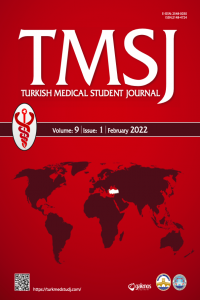PATHOPHYSIOLOGY, CLINICAL FEATURES AND TREATMENT OF MICROVASCULAR ANGINA: A REVIEW
PATHOPHYSIOLOGY, CLINICAL FEATURES AND TREATMENT OF MICROVASCULAR ANGINA: A REVIEW
Microvascular angina coronary syndrome, angina pectoris,
___
- 1. Gandhi MM, Lampe FC, Wood DA. Incidence, clinical char- acteristics, and short-term prognosis of angina pectoris. Heart 1995;73(2):193-8.
- 2. Hermann LK, Weingart SD, Yoon YM, et al. Comparison of fre- quency of inducible myocardial ischemia in patients presenting to emergency department with typical versus atypical or nonanginal chest pain. Am J Cardiol 2010;105(11):1561-4.
- 3. Baggiano A, Guglielmo M, Muscogiuri G et al. (Epicardial and microvascular) angina or atypical chest pain: differential diag- noses with cardiovascular magnetic resonance. Eur Hear J Suppl 2020;22:116-30.
- 4. Park JJ, Park SJ, Choi DJ. Microvascular angina: Angina that pre- dominantly affects women. Korean J Intern Med 2015;30(2):140-7.
- 5. Bøtker HE, Sonne HS, Sørensen KE. Frequency of systemic mi- crovascular dysfunction in syndrome x and in variant angina. Am J Cardiol 1996;78(2):182-6.
- 6. Dessalvi CC, Deidda M, Giorgi M et al. Vascular damage – coro- nary artery disease. J Cardiovasc Echogr 2020;30:11-6.
- 7. Algranati D, Kassab GS, Lanir Y. Why is the subendocardium more vulnerable to ischemia? A new paradigm. Am J Physiol - Hear Circ Physiol 2011;300(3):1090-100.
- 8. Kayikcioglu M, Payzin S, Yavuzgil O et al. Benefits of statin treat- ment in cardiac syndrome-X1. Eur Heart J 2003;24(22):1999-2005.
- 9. Ford TJ, Corcoran D, Berry C. Stable coronary syndromes: Pathophysiology, diagnostic advances and therapeutic need. Heart 2018;104(4):284-92.
- 10. Lanza GA, De Vita A, Kaski JC. “Primary” microvascular angi- na: clinical characteristics, pathogenesis and management. Interv Cardiol Rev 2018;13(3):108-11.
- 11. Alroy S, Preis M, Barzilai M et al. Endothelial cell dysfunction in women with cardiac syndrome X and MTHFR C677T mutation. Isr Med Assoc J 2007;9(4):321-5.
- 12. Seery JP. Therapeutic approach to microvascular angina (syn- drome x). J Am Coll Cardiol 1995;25(6):1472.
- 13. O’Rourke MF, Nichols WW. Microvascular angina or “vis a ter- go.” J Am Coll Cardiol 2010;55(6):611.
- 14. Gould KL, Johnson NP. Coronary physiology beyond coronary flow reserve in microvascular angina: jacc state-of-the-art review. J Am Coll Cardiol 2018;72(21):2642-62.
- 15. Kaski JC, Russo G. Cardiac syndrome X: an overview. Hosp Pract 2000;35(2):75-94.
- 16. Khera R, Secemsky E, Wang Y et al. Revascularization prac- tices and outcomes in patients with multivessel coronary ar- tery disease who presented with acute myocardial infarction and cardiogenic shock in the us, 2009-2018. JAMA Intern Med 2020;180(10):1317-27.
- 17. Berry C, Sidik N, Pereira AC et al. Small-vessel disease in the heart and brain: current knowledge, unmet therapeutic need, and future directions. J Am Heart Assoc 2019;8(3):e011104.
- 18. Rahman H, Demir OM, Khan F et al. Physiological stratification of patients with angina due to coronary microvascular dysfunction. J Am Coll Cardiol 2020;75(20):2538-49.
- 19. Pelletier-Galarneau M, Dilsizian V. Microvascular angina diag- nosed by absolute PET myocardial blood flow quantification. Curr Cardiol Rep 2020;22(2):9.
- 20. Manfrini O, Amaduzzi P, Bergami M et al. Effects of statin treat- ment on patients with angina and normal or nearly normal angio- grams. Eur Cardiol 2020;15:e15.
- ISSN: 2148-4724
- Başlangıç: 2014
- Yayıncı: Trakya Üniversitesi
THE FOURTH HORSEMAN OF 21ST CENTURY: COVID-19 PANDEMIC
İnci KADRİBEY, Fatih Erkan AKAY
MYOCARDIAL INFARCTION DIAGNOSIS AND CARDIAC TROPONINS
Berra KURTOĞLU, Burcu ERKILIÇ, Dilay Yağmur GÜRSEL, Gülsüm ARSLAN, Ogün BACAKSIZOĞLU, Pınar ALTUNDAL, Selin KARA, Yasemin ARDIÇOĞLU
DISTANCE EDUCATION IN MEDICAL SCHOOLS: THE EXPERIENCE AND OPINIONS OF ACADEMICIANS AND STUDENTS
Hilal Sena ÇİFCİBAŞI, Berkay KEF, Irmak İrem ÖZYİĞİT, Sezin SAYIN, Aslı GÖZTEPE, Selis Gülseven GÜVEN, Serkan ATICI
THE EFFECT OF 5-FU AND RUXOLITINIB ON MITOCHONDRIAL APOPTOSIS IN GLIOBLASTOMA U87 CELL LINE
Gonca AKSU, Oğuzhan DOĞANLAR, Zeynep Banu DOĞANLAR
PATHOPHYSIOLOGY, CLINICAL FEATURES AND TREATMENT OF MICROVASCULAR ANGINA: A REVIEW
Hasan Selçuk ÖZKAN, Meral KAYIKÇIOĞLU
INVESTIGATION OF THE PARAMETERS THAT MAY PREDICT HEMODIALYSIS FREQUENCY
Gökhan KIRAL, Alperen Taha CERTEL, Irmak İrem ÖZYİĞİT, Begüm SÖYLEYİCİ, Güray AYGÜN, Cenk GÖKALP
Elif CENGİZ, Fevzi Oktay ŞİŞMAN, Beliz KOÇYİĞİT, Mehmet Gürkan ARIKAN, Tevfik AKTOZ
JUVENILE POLYP FROM SYMPTOM TO DIAGNOSIS AND THE ROLE OF ULTRASONOGRAPHY: A CASE REPORT
